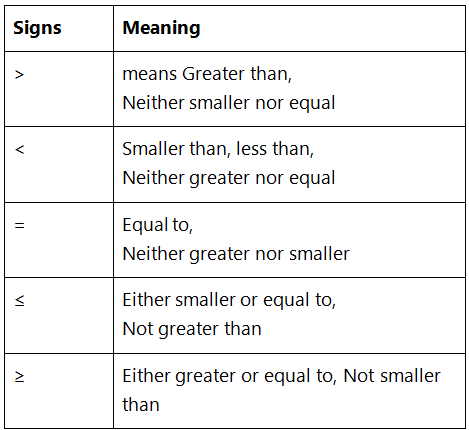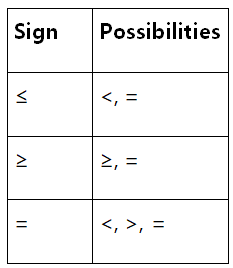Coded Inequalities, Introduction and Examples (with Solutions), Reasoning | IBPS PO Prelims & Mains Preparation - Bank Exams PDF Download
| Table of contents |

|
| Decoding inequality signs |

|
| How to solve questions on coded inequalities in reasoning section? |

|
| How to solve Possibilities? |

|
| Solved Examples of Coded Inequality for Reasoning Section |

|
Decoding inequality signs
Before, we proceed further, we should know how to correctly decode the signs. The following table shows different signs and their meanings:
How to solve questions on coded inequalities in reasoning section?
When solving inequalities, we will consider the following cases:-
Case 1: Equal to
The first step in every equation is to ignore equal. Yes ignore. Please read the following example to know why we want you to ignore ‘equal to’ sign:
Example 1: A = B <C = D
Therefore, B < D
Example 2: A < B = C
Therefore, A < C. (A is the smallest)
Case 2: Same Sign
When same sign repeats itself again and again, then such sign would be the answer.
Example 3: A < B < C < D
Therefore, A < D. (A is the smallest)
Example 4: A = B ≥ C = D ≥ E
Therefore, A ≥ E
Case 3: Common Sign
(= is never considered as a common sign). So, the first thing to be done is to ignore (=) as ignore told in Case 1.
Example 5: A < B ≤ C
Therefore, A < C.(A is the smallest)
Example 6: A ≥ B > C = D ≥ E > F
Therefore, A > F.
Case 4 : Opposite sign
Whenever there are opposite sign there are 3 possibilities.
For instance, A > B ≤ C (No relation), there will be 3 possibilities:
A = C
A > C
A < C
We can even understand it in another way
A > B
C ≥ B
So, no relationship can be found between A and C.
Example 7: A < B ≤ C = D ≤ E
Conclusion 1: A < E
Conclusion 2: A ≤ E
Conclusion 3: A > D
Conclusion 4: B = E
Which conclusion(s) follow(s)?
In this example, only Conclusion 1 follows.
Conclusion 2 is wrong because common sign between A and E is <.
Conclusion 3 is wrong because A < D.
Conclusion 4 is wrong because B ≤ E. ( B = E is just a possibility)
How to solve Possibilities?
There can be 2 cases:1. Either - or
If two possibilities are given in the conclusions and both such conclusions have the same variable, we apply ‘either or’ between the conclusions. This means at a time one of the two conclusions will surely be true.
This is the most tricky type of snaswer. Let's have a look at the following example in order to understand this point:-
Example 8: A < B ≤ C > D = E ≤ F
Conclusion 1: A ≤ D
Conclusion 2 : A > D
Conclusion 3: A =D
Conclusion 4: A ≤ C
In this case correct answer will be Either 1 or 2 follows because there are opposite signs between A and D ( <, ≤, >). So, in this case there will be 3 possibilities as explained earlier.
Since all the three possibilities are present in conclusion 1 or 2, we apply either or case.
Let us now consider another example:
Example 9: A < B ≥ C =E = F > D
Option 1: A < C
Option 2: A > C
Option 3: F ≥ B
Option 4 : D < F
In this correct answer will be Option 4.
In option 1 & option 2, we cannot apply either or case because only 2 possibilities are given but according to the questions, there can be 3 possibilities between A and C.
2. Wrong
If all the possible possibilities are not given the conclusion i.e only some of the possibilities are given, then those conclusions will be considered wrong.
Solved Examples of Coded Inequality for Reasoning Section
Now, we solve one miscellaneous question to thoroughly understand the concept:
Example 10:
X @ Y means X is not smaller than Y
X % Y means X is not greater than Y
X $ Y means X is neither smaller than nor greater than Y
X # Y means X is neither greater than nor equal to Y
X * Y means X is neither smaller than nor equal to Y
Statements: W % E, P % E, P @ S.
Conclusions:
I: S * E.
1. W $ S
(a) Only conclusion I follows
(b) Only conclusion II follows
(c) Both conclusion I and conclusion II follow
(d) Neither conclusion I nor conclusion II follows
(e) Either conclusion I or conclusion II follows
Ans: (d)
Sol: W % E implies W < E
P % E implies P < E
P @ S implies P > S
Hence, the consolidated relationship is E > P > S and E > W
Conclusion I: S * E implies S > E, which is definitely false.
Conclusion II: W $ S implies W = S, which may or may not be true as the relationship between S and W cannot be established.
Hence, neither conclusion follows.
Hence, option 4.
|
647 videos|1023 docs|305 tests
|
FAQs on Coded Inequalities, Introduction and Examples (with Solutions), Reasoning - IBPS PO Prelims & Mains Preparation - Bank Exams
| 1. What are coded inequalities and how are they used in reasoning? |  |
| 2. How can I solve coded inequalities effectively? |  |
| 3. Can you provide an example of solving a coded inequality? |  |
| 4. Are there any specific strategies or tips for solving coded inequalities quickly? |  |
| 5. What are some common mistakes to avoid when solving coded inequalities? |  |




















